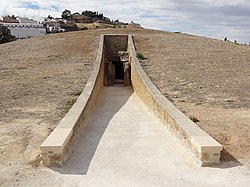Dolmen de Viera
| Dolmen de Viera Cueva de Viera | ||
|---|---|---|
|
Entrance of the dolmen from the east |
||
|
Location in the province of Málaga |
||
| Coordinates | 37 ° 1 '24.5 " N , 4 ° 32' 56.4" W | |
| place | Antequera , Málaga , Andalusia , Spain | |
| Emergence | around 3500-3000 BC Chr. | |
| Dimensions | about 50 × 20 meters | |
The Dolmen de Viera (also Cueva de Viera ) near Antequera ( Andalusia ) is one of the most important buildings of Neolithic architecture in Europe. Together with the Dolmen de Menga and the Tholos de El Romeral , about 1.7 kilometers away , it forms a unique ensemble of Stone Age buildings. The Antequera Dolmen Sites was added to the UNESCO World Heritage List in June 2016 .
location
The Dolmen de Viera is located in the east of Antequera, only about 90 meters southwest of the Dolmen de Menga .
Dating
The dating of the building is unclear - older research advocated an age of around 4000 to 4500 years, while recently a much earlier date and thus a significantly higher age of around 5000 to 5500 years has been assumed. In any case, the buildings of the Dolmen de Menga and the Dolmen de Viera are not only close to one another in terms of space, but also in time. The Dolmen de Viera was discovered in 1903/05 by the brothers Antonio and José Viera and bears their name.
architecture

The grave mound (tumulus) of the Dolmen de Viera , piled with covered with soil small stones, has a diameter of about 50 meters. A passage that is always unlocked and faces east - south - east ( azimuth 96 °) leads into the interior of the hill . H. roughly to the highest level of the sun in June, whose rays then still illuminate the corridor at dawn. Part of the tumulus has been eroded over time - probably by rain and wind - so that the megaliths in the front corridor area were exposed to the weather, which led to considerable destruction. The restoration of the entrance area roughly matches the original dimensions and also shows the half-destroyed orthostats and capstones.
The originally about 22 meter long corridor to the burial chamber is still a little over 21 meters long due to the lack of stones at the entrance. It was built from large stone blocks ( megaliths ) that were precisely hewn and joined together , probably sixteen on each side, of which there are fourteen on the left wall and fifteen on the right. Five of the capstones are still intact and two are incomplete, three or four are missing. The corridor is about 1.30 meters wide at the front and 1.60 meters at the burial chamber. The average height is just over 2 meters. It ends at a transverse megalithic stone, in the middle of which there is a roughly 60 × 80 centimeter rectangular opening, which is sometimes also referred to as a soul hole . Behind it is a square burial chamber, only slightly larger than the corridor (width and depth approx. 1.80 meters; height 2.05 meters).
Individual evidence
- ↑ Antequera dolmens are a UNESCO World Heritage Site. Travels to Spain, 2016, accessed November 30, 2016 .
- ↑ Chris Chaplow: Menga, Viera and El Romeral Dolmens. www.andalucia.com, accessed October 19, 2015 .
- ↑ a b Conjunto Arqueológico Dólmenes de Antequera. Junta de Andalucía, Consejería de Educación, Cultura y Deporte (Spanish)
Web links
- Dolmen de Viera - photos, sketches + information (Spanish)
- Conjunto Arqueológico Dólmenes de Antequera. Junta de Andalucía, Consejería de Cultura (Spanish)
- Dolmen de Viera Patrimonio Inmueble de Andalucía (Spanish)
- Dolmenes de Antequera. (Spanish)



